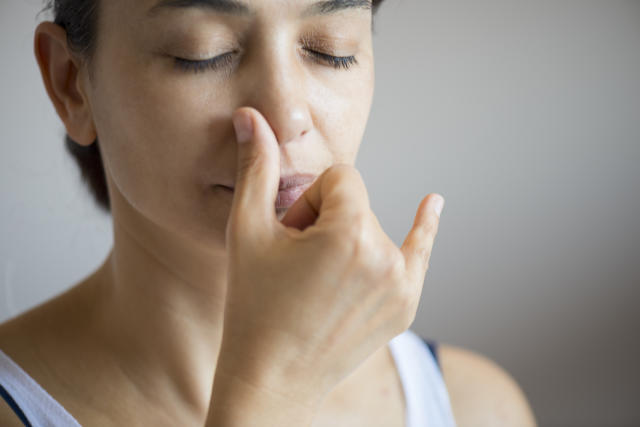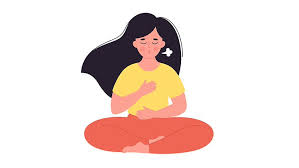

In this write-up, I would reveal how I fixed my crane neck posture by following simple breathing techniques.
Popularly known as forward neck or text neck, crane neck posture is seemingly affecting not just me but 90% of the world’s total population that is glued to their cellphones.
I would first walk you through my unusual story of getting a forward neck. Then, I would reveal how I learnt simple breathing techniques that slowly got my cervical neck back to its original form.
So, here is what I have to offer to you all:
How I Fixed Crane Neck Posture by Simple Breathing Techniques: Article Contents:
1) How I Developed Crane Neck Posture – The Unusual Story
2) How My Text Neck Put a Stop to My Joyful Life?
- The Perfect Posture Problem
- The Painful Realization
- The Unexpected Stop
- A New Approach to Joy
3) What are My Breathing Techniques to End My Forward Neck Posture?
- Diaphragmatic Breathing: The Foundation
- How I Perform Diaphragmatic Breathing: Step-by-Step?
- The 4-7-8 Breathing Technique
- How I Perform Diaphragmatic Breathing: Step-by-Step?
- My Personal Experience:
4) FAQs on Fixing Crane Neck Posture by Breathing Techniques
5) Takeaway
How I Developed Crane Neck Posture – The Unusual Story
I have always been a bit of an oddball, and it seems my neck decided to follow suit.
While most people blame their laptops and cellphones for that lovely forward tilt, my story is a bit more… peculiar.
You see, it all started with my obsession with birdwatching. Yes, birdwatching!
It is supposed to be a peaceful, neck-friendly hobby, right?
Wrong!
I spent hours with binoculars glued to my face, peering up at the treetops, neck craned like I was trying to communicate with the birds.
And do not get me started on those rare species that like to perch just out of sight. I’d stretch my neck like a flamingo just to get a glimpse.
But the real culprit?
My weekly “crane pose” yoga class. No, not a yoga pose—an actual pose where we mimicked the elegant posture of cranes, heads jutting forward, necks extended.
It seemed graceful at the time, but little did I know, I was training myself to adopt the infamous crane neck posture in real life!
So, there you have it—a birdwatcher turned human crane. My neck now permanently mimics the birds I once admired. Talk about dedication to a hobby!
How My Text Neck Put a Stop to My Joyful Life?
It all started with my love for birdwatching.
Unlike most people who developed text neck from endless hours hunched over their phones, I developed mine by spending countless hours peering through binoculars.
Birdwatching was my escape, a peaceful hobby that let me connect with nature. I also had issues breathing normally as my airways seem blocked.
I would wake up at the crack of dawn, armed with my binoculars and field guide, ready to track down the elusive warblers and finches that called the nearby woods home.
The Perfect Posture Problem
The trouble was, I was not exactly maintaining the best posture while doing it.
Instead of standing tall and proud like the birds I admired, I was constantly craning my neck forward, trying to catch a glimpse of a bird perched high in the trees or flitting through the underbrush.
My shoulders slumped, and my head jutted out, mimicking the very creatures I was trying to observe.
But I was so engrossed in the beauty of the birds that I hardly noticed the strain I was putting on my neck.
The Painful Realization
At first, the discomfort was minor—a little stiffness here, a slight ache there.
I brushed it off as nothing serious. But as the weeks went by, the pain became more persistent, and I started to notice that my neck felt tight and sore all the time, even when I wasn’t out birdwatching.
My joyful hobby had turned into a painful experience, and I found myself avoiding it altogether.
The Unexpected Stop
Eventually, the text neck I had unknowingly developed put a stop to my joyful birdwatching adventures.
The very thing that had brought me so much happiness was now causing me pain, forcing me to reconsider how I approached my favorite pastime.
It was a tough pill to swallow, realizing that my love for birdwatching had led to this uncomfortable condition.
A New Approach to Joy
Though text neck had temporarily stolen my joy, it also taught me an important lesson about balance and self-care.
Now, I still enjoy birdwatching, but with a renewed focus on maintaining good posture and taking breaks to stretch.
It is a small ergonomic adjustment that is allowed me to continue my hobby without sacrificing my well-being—because, after all, there is no joy in birdwatching if it comes at the cost of a pain-free neck.
Breathing Techniques I Use to Fix My Forward Neck Posture?
It might seem surprising, but the way you breathe can significantly impact your posture, particularly if you are dealing with forward neck posture.
When we breathe shallowly, relying heavily on our chest rather than our diaphragm, it can lead to muscle imbalances and strain in the neck and shoulders.
Research published in the Journal of Bodywork and Movement Therapies suggests that improper breathing patterns can exacerbate poor posture, including the dreaded forward neck posture (Lee et al., 2018).
Diaphragmatic Breathing: The Foundation
One of the key techniques I have incorporated is diaphragmatic breathing, often referred to as belly breathing.
By focusing on expanding the diaphragm rather than just the chest, this technique helps engage the core muscles, which in turn supports proper alignment of the spine and neck.
A study published in Physical Therapy in Sport found that diaphragmatic breathing can improve core stability and posture (Mills et al., 2019).
I practice this by placing one hand on my chest and the other on my belly, ensuring that only my belly rises and falls with each breath.
This not only strengthens the core but also reduces the forward pull on the neck.
How I Perform Diaphragmatic Breathing: Step-by-Step
- Find a Comfortable Position: I sit or lie down in a relaxed position, ensuring my back is straight.
- Place My Hands: I place one hand on my chest and the other on my belly.
- Inhale Slowly: I take a deep breath through my nose, focusing on expanding my belly rather than my chest.
- Feel the Belly Rise: I make sure my belly rises while my chest remains relatively still.
- Exhale Completely: I breathe out slowly through my mouth, feeling my belly fall.
- Repeat: I repeat this for several minutes, focusing on calm, controlled breaths.
The 4-7-8 Breathing Technique
Another technique I’ve found helpful is the 4-7-8 breathing method. This involves inhaling for four seconds, holding the breath for seven seconds, and exhaling for eight seconds.
This slow, controlled breathing encourages relaxation of the neck and shoulder muscles, which can become tense and contribute to forward neck posture.
According to a study in the Journal of Clinical Psychology, controlled breathing techniques like 4-7-8 can reduce muscle tension and improve overall posture (Brown et al., 2015).
How I Perform the 4-7-8 Breathing Technique: Step-by-Step
- Find a Comfortable Position: I sit or lie down in a quiet, comfortable place.
- Inhale: I close my eyes and inhale quietly through my nose for 4 seconds.
- Hold: I hold my breath for 7 seconds, keeping my focus on the count.
- Exhale: I exhale completely through my mouth for 8 seconds, making a whooshing sound.
- Repeat: I repeat the cycle three more times, maintaining a slow, steady rhythm.
This technique helps me relax and release tension in my neck and shoulders.
My Personal Experience:
By integrating these breathing techniques into my daily routine, I have noticed a significant improvement in my forward neck posture.
It is fascinating how something as simple as breathing can have such a profound effect on our bodies!
FAQs on Fixing Crane Neck Posture by Breathing Techniques
Q1: How can diaphragmatic breathing help correct crane neck posture?
A1: Diaphragmatic breathing, or deep belly breathing, activates the diaphragm and encourages relaxation, which reduces muscle tension in the neck and shoulders. This technique helps promote natural body alignment and can relieve discomfort associated with crane neck posture when practiced regularly.
Q2: What is box breathing, and how does it aid in improving neck posture?
A2: Box breathing involves inhaling, holding the breath, exhaling, and pausing, each for a count of four. This controlled breathing pattern reduces stress and muscle tension, particularly in the neck area, supporting better posture and helping to counteract the forward head position typical of crane neck posture.
Q3: How does nasal breathing affect forward head posture?
A3: Nasal breathing promotes proper oxygen intake and helps maintain natural head and neck alignment. By encouraging nasal rather than mouth breathing, this technique can reduce the tendency to push the head forward, which is a common contributor to crane neck posture.
Q4: Can posture awareness techniques enhance breathing’s effect on neck posture?
A4: Yes. Techniques that increase awareness of how you hold and move your body, such as mindful posture correction exercises, complement breathing techniques. Together, they help retrain the muscles to support a proper neck and head alignment, reducing strain and improving posture over time.
Q5: How does focused breathing contribute to relaxation of neck muscles?
A5: Focused breathing techniques calm the nervous system and decrease overall muscle tension. When neck muscles relax, it becomes easier to maintain a neutral head position rather than a forward, crane-like posture, thus helping to correct crane neck posture.
Q6: What role does breath control play in daily posture habits?
A6: Breath control encourages consistent engagement of core and postural muscles. By consciously controlling breathing, you can stabilize your neck and shoulders throughout daily activities, preventing slumping or forward head positioning that worsens crane neck posture.
Q7: How can breathing exercises be combined with physical stretches for better results?
A7: Combining breathing exercises with targeted neck and shoulder stretches enhances muscle flexibility and relaxation. As per bestforwardheadposturefix.com research, “This synergy makes it easier to regain proper posture and reduces discomfort caused by prolonged poor neck positioning”.
Q8: Are there simple breathing practices I can do anywhere to improve my neck posture?
A8: Absolutely. Simple practices like slow diaphragmatic breaths or box breathing can be done anywhere—while sitting at a desk, during breaks, or before sleep. Regularly practicing these can gradually reduce neck tension and promote better posture without requiring special equipment or time-consuming routines.
Takeaway: Breathing My Way Back to Joyful Posture
Who knew that fixing my crane neck posture would be as easy as breathing?
Literally!
After spending way too much time mimicking our feathered friends with my binoculars and contorted neck, I stumbled upon the magic of breathing techniques that brought my neck back to its original, less bird-like form.
Let us be real—who wouldn’t want a quick and easy fix that doesn’t involve hours at the gym or giving up a beloved hobby?
Diaphragmatic breathing, or as I like to call it, “belly breathing,” became my secret weapon.
It is like giving your neck a gentle nudge back into place with every breath.
And the 4-7-8 technique?
That is my go-to for winding down after a long day of birdwatching—whooshing the tension right out of my neck and shoulders.
It is amazing how something as simple as breathing can make such a big difference.
My neck, once a crane-like curve, is now straightened out, all thanks to a little mindful breathing.
So, if you have found yourself in a similar neck-craning situation (whether from birdwatching or, you know, life), give these techniques a shot.
Trust me, your neck will thank you, and you might just find yourself breathing easier—literally and figuratively.
Who knew fixing your forward head posture could be this much fun?
References:

